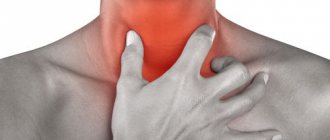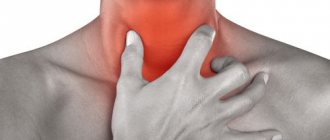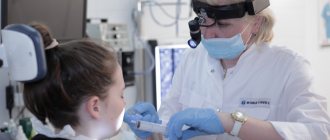Video
Pain in the neck. Question answer
Topic: Questions and Answers
Neck pain (Cervicalgia)
Topic: Encyclopedia of diseases
Title
- Causes of the disease
- Symptoms
- Diagnostics
- Treatment methods
Neck pain ( cervicalgia ) is a common pain syndrome. About 10 percent of adults experience neck pain at least once in their lives. Cervicalgia (neck pain) can be caused by a number of factors, including muscle strain, ligament strain, arthritis, or nerve root compression. Neck pain can occur from a number of diseases of the spine and diseases of any tissue in the neck area. In addition, neck pain can be associated with infections, for example, viral throat infections lead to swollen lymph nodes and neck pain. Neck pain may also be associated with rare infections such as tuberculosis, osteomyelitis, septic discitis or meningitis (often accompanied by a stiff neck). Neck pain can be caused by diseases that affect the muscle structures of the neck (fibromyalgia or polymyalgia rheumatica). Provoking factors for neck pain are contact sports, injuries such as road traffic accidents, and excessive physical activity.
How to tell if you have dystonia
People who live with vegetative-vascular dystonia for quite a long time get used to their symptoms if they do not manifest themselves as crises and do not disrupt the normal course of life.
They learn to live with headaches, endure periodic numbness in their arms or legs, sometimes suffer from rapid heartbeat, and know that when the weather changes, they may experience insomnia. The rest of the time, VSD does not make itself felt and does not cause life-threatening conditions. But some manifestations of dystonia feel truly scary. A lump in the throat and a feeling of lack of air, palpitations and fear during panic attacks, sudden loss of consciousness, pressure changes. If after such an incident you were examined and no dangerous diseases were found, then with a high probability we can talk about VSD.
Numbness of the limbs with dystonia is usually associated with an unpleasant experience. Such a reaction of the body can occur even in anticipation of a pleasant event, from an excess of emotions.
Feeling of a lump in the throat with VSD
Very often you can find in people suffering from VSD the sensation of a lump in the throat. It's one thing when there is a logical, although there may be an unpleasant and frightening explanation, for example, a tumor or severe inflammation that causes a narrowing of the larynx. But what to do in cases where there is a lump, but there are no reasons for it, and turning to a variety of specialists gives the same result: the person who contacts them has no reason to feel a lump.
What are the symptoms of a lump in the throat?
This symptom of VSD, like a lump in the throat, appears completely suddenly. One fine morning there is a feeling that something is interfering, preventing you from swallowing and breathing deeply as usual. At the same time, five minutes ago everything was in order, but any ordinary or everyday situation, accompanied by a little excitement, an increase in blood pressure and an increase in heart rate - and now, the feeling that someone is squeezing the neck. All you have to do is drink a sedative, come to your senses a little, and your condition will return to normal. But in any other stressful situation, the feeling of a lump in the throat appears again.
Unpleasant sensations can be either constant or periodic. At the same time, the sensations may differ from person to person; it may be a tickling sensation, a tingling sensation, a feeling of squeezing, or the inability to swallow, whether it is saliva or solid food.
Sometimes the feeling of a lump can develop into a state in which a person may realize that he has forgotten how to swallow and cannot do it. Then it comes to a panic attack. So, over time, a fear of swallowing in general and eating solid food may develop.
Causes of a lump in the throat with VSD
Vegetative-vascular dystonia in itself is a nervous disorder; suffering from VSD, a person is constantly in panic and fear of something. This, in turn, is triggered by the release of large doses of adrenaline into the blood.
Which part of the body the adrenaline will choose to express itself is not clear. For some, this manifests itself in pain in the chest area, for others, the gastrointestinal tract suffers, and for others, they experience spasms of the laryngeal muscles, which is the very sensation of a lump in the throat.
It is worth remembering that no other disease, for example, an enlarged thyroid gland, osteochondrosis or aneurysm, gives symptoms similar to a coma, no matter what anyone says.
What could be bothering your throat?
People who first feel a lump in their throat first think of the worst, of course, cancer. What else could create such sensations of interference if not a tumor? And the more panic moods grow in a person, the stronger the lump is felt.
You need to know that the most important difference between a lump in the throat during VSD and any serious disease of the larynx, esophagus or other respiratory organs is that during sleep the lump is not felt at all. When I wake up, everything is fine too. But as soon as you get up and feel more energetic, the sensations return. The whole point here is that until the brain woke up, the body felt good, but as soon as the brain returned to working condition, it remembered that there should be a lump, and the patient felt it again.
It is the normal state of the throat in the first five minutes after waking up that should assure a person that the issue here is not some mythical disease, but the state of the nervous system.
How to treat a lump in the throat?
In fact, it is very difficult for any person suffering from VSD to admit to himself that the problem is not a disease at all, but a disorder of the nervous system. Treatment for coma is the same as for VSD therapy.
- Taking psychotropic medications that reduce panic attacks to a minimum and have a calming effect in a dosage that is relevant for a particular patient.
- An attempt to come to terms with the fear of death and liberation from oppressive terrible thoughts. You can seek advice on this issue from a psychotherapist, but you will have to work on yourself on your own.
The feeling of a lump in the throat will not go away on its own and will poison your life.
He needs to be treated. Author: K.M.N., Academician of the Russian Academy of Medical Sciences M.A. Bobyr
What other diseases cause numbness in hands, feet and tongue?
Lesions of the cervical, cranial, and lumbar nerves can cause numbness. But in addition to this, other symptoms are usually present: pain, tingling, dysfunction (claudication, arm weakness, slowness and blurred speech).
Metabolic diseases can also cause changes in sensitivity, including numbness of body parts. If you often limit yourself to meat, fish, eggs, and do not supplement your diet with synthetic vitamin B12, then this can cause metabolic disorders and cause weakness in your arms and legs.
Loss of sensation in the left hand may be one of the classic symptoms of myocardial infarction. At the same time, the general condition worsens, the person looks very pale or, on the contrary, turns red, dizziness or headache, a feeling of heaviness in the chest or a burning sensation appears.
A hernia in one part of the spine can put pressure on a nerve, causing pain or loss of sensation.
Decreased sensation in the feet can be a complication of diabetes. This is one of the first signs of diabetic foot and should be reported to your doctor as soon as possible.
Causes
There are quite a few causes of neck pain, and it is not always possible to immediately determine the source of the pain, and sometimes even with the help of instrumental research methods it can be difficult to determine the true cause of the pain. The main conditions causing neck pain are the following:
Neck sprain . A strained neck muscle can be caused by an injury that can cause the neck muscles and upper back muscles to spasm. Strained neck muscles can be the result of systematic static loads associated with poor posture, psychological stress or lack of sleep. Typically, symptoms of a neck strain include pain, stiffness and discomfort in the upper back or shoulder and symptoms can last up to six weeks.
Cervical spondylosis is degenerative changes in the vertebrae in the cervical spine, in which changes in the shape of the vertebrae and bone growths along the edges of the vertebrae (osteophytes) occur. Osteophytes can exert compression on surrounding tissues (including nerve structures). Research shows that almost 90% of nerve compression cases are caused by osteophytes. Moderate manifestations of spondylosis are a common involutional process associated with the aging of the body, while significant manifestations of spondylosis are a pathological degenerative process. Symptoms of cervical spondylosis may include neck pain or weakness, numbness or discomfort in the arms or shoulders, headaches, or limited neck mobility.
Discogenic neck pain . Discogenic neck pain is believed to be the most common type of neck pain. The cause of discogenic pain is morphological changes in the structure of one or more intervertebral discs. Characteristic symptoms of discogenic neck pain are pain in the neck when turning or tilting the head. Pain may intensify when the neck is subjected to prolonged static load, when the neck is in one position for a long time (for example, when driving a car, when working at a computer). The pain may be accompanied by muscle stiffness and muscle spasms. Discogenic pain may also radiate to the arm and shoulder.
Facet joint syndrome – The facet joints are located at the edges of the vertebrae and are most often damaged by whiplash injuries and are often the source of headaches. Another potential cause of facet joint damage may be the nature of the job, which requires frequent neck extension. Symptoms of facet joint syndrome in the cervical spine include pain in the middle or side of the neck, and some patients may have pain in the shoulder at the scapula, at the base of the skull, or in one arm.
Whiplash – Whiplash syndrome is caused by a traumatic incident of sudden hyperextension of the neck (forward – backward). The most common cause of this injury is a motor vehicle accident. Symptoms of whiplash include severe pain, muscle spasms, and decreased range of motion in the neck.
Cervical myofascial pain – myofascial pain is characterized by the presence of dense and painful points in the neck area. Myofascial neck pain can develop after injury or be caused by conditions such as psychological stress, depression or insomnia.
Diffuse skeletal hyperostosis - Diffuse skeletal hyperostosis is a syndrome in which abnormal calcification occurs in the ligaments and tendons in the cervical spine, resulting in tissue hardening. Many patients are asymptomatic, but some may experience stiffness, pain, and decreased mobility. Diffuse skeletal hyperostosis can occur not only in the cervical spine, but also in the thoracic and lumbar regions.
Cervical spondylogenic myelopathy occurs when there are degenerative changes that lead to narrowing of the spinal canal. Spinal stenosis can lead to damage (compression) of the spinal cord and neurological impairment. Therefore, in addition to pain, patients may have weakness in the limbs, poor coordination of movements, as well as dysfunction of the pelvic organs (intestines, bladder, erectile dysfunction).
Cervical Radiculopathy – Cervical radiculopathy occurs when the nerve roots are irritated by a herniated disc or other formation, such as a synovial cyst. Signs of radiculopathy may include pain, weakness, or sensory disturbances (eg, numbness, tingling) in the arms. The most common causes of cervical radiculopathy are degenerative changes in the cervical spine (osteochondrosis).
What will help restore sensitivity?
If during VSD your arms or legs are numb, you feel chills - take a hot shower, put on socks, wrap yourself in a warm blanket.
A hot drink will not only warm you up, but also activate reflex mechanisms that will return normal sensitivity to your limbs.
If numbness occurs after stress, take a sedative and try to sleep. For vegetative-vascular dystonia, Glycine is the best choice. Unlike herbal preparations, it will improve metabolism in nervous tissue at the cellular level and help recover from stress.
The combination of glutamic acid, glycine and cystine in Eltacin® helps to gradually bring dystonia under control and reduce the frequency of all symptoms. We recommend taking it in courses, as well as if your arms, legs or tongue become suddenly numb. After two or three courses of amino acids, manifestations of VSD will bother you less and less often, including sensory disturbances.
Symptoms
As a rule, neck pain is dull in nature. Sometimes the pain gets worse when you move your neck. Neck pain may be accompanied by numbness, tingling, sometimes the pain can be acute, there may be difficulty swallowing, enlarged lymph nodes, and dizziness.
Cervicalgia may be associated with facial headache, shoulder pain, or numbness or tingling in the shoulder (upper limb paresthesia). Such associated symptoms often result from root compression. For example, compression of a root with sensory fibers providing innervation to the occipital region can lead to neck pain radiating to the back of the head. Depending on the disease, in some cases, neck pain may be accompanied by pain in the upper back or lower back, for example with ankylosing spondylitis, when the inflammatory process covers the entire spine.
Diagnostics
Cervicalgia requires a clear identification of the cause of the pain. A full examination is especially necessary when neck pain is accompanied by neurological symptoms (dysfunction of the pelvic organs) or the pain is intense, there are sensory disturbances (numbness, tingling) or the pain lasts for more than a week of treatment at home.
During the examination, the doctor should assess the presence of painful points in the neck, range of motion in the neck, the presence of muscle spasms, the condition of the muscles of the neck and shoulders, the presence of muscle weakness, tension in muscle groups in the upper torso.
In some cases, instrumental studies such as X-rays, computed tomography (CT), magnetic resonance imaging (MRI), or ENMG (nerve fiber conduction testing) are necessary. These research methods help verify the diagnosis.









